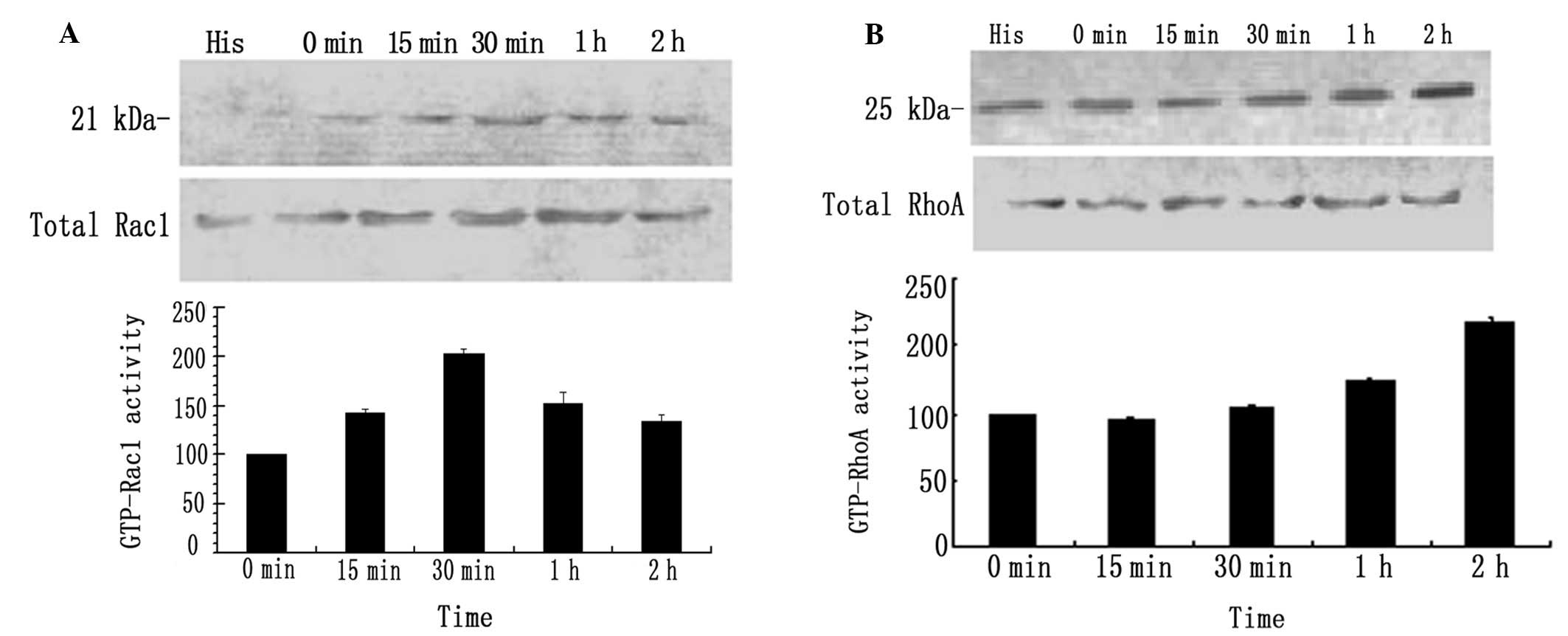|
1
|
Chakraborty AK, Funasaka Y, Araki K,
Horikawa T and Ichihashi M: Evidence that the small GTPase Rab8 is
involved in melanosome traffic and dendrite extension in B16
melanoma cells. Cell Tissue Res. 314:381–388. 2003. View Article : Google Scholar
|
|
2
|
Fitzpatrick B, Miyamoto M and Ishikawa K:
The evolution of concepts of melanin biology. Arch Dermatol.
96:305–323. 1967. View Article : Google Scholar : PubMed/NCBI
|
|
3
|
Scott G: Rac and Rho: the story behind
melanocyte dendrite formation. Pigment Cell Res. 15:322–330. 2002.
View Article : Google Scholar : PubMed/NCBI
|
|
4
|
Hara M, Yaar M and Gilchrest BA:
Endothelin-1 of keratinocyte origin is a mediator of melanocyte
dendricity. J Invest Dermatol. 105:744–748. 1995. View Article : Google Scholar : PubMed/NCBI
|
|
5
|
Busca R, Bertolotto C, Abbe P, Engalo W,
Ishizaki T, Narumiya S, Boquet P, Ortonne JP and Ballotti R:
Inhibition of Rho is required for cAMP-induced melanoma cell
differentiation. Mol Biol Cell. 9:1367–1378. 1998. View Article : Google Scholar : PubMed/NCBI
|
|
6
|
Yoshida M, Takahashi Y and Inoue S:
Histamine induces melanogenesis and morphologic changes by protein
kinase A activation via H2 receptors in human normal melanocytes. J
Invest Dermatol. 114:334–342. 2000. View Article : Google Scholar : PubMed/NCBI
|
|
7
|
Hata K, Hori K, Murata J and Takahashi S:
Remodeling of actin cytoskeleton in lupeol-induced B16 2F2 cell
differentiation. J Biochem. 138:467–472. 2005. View Article : Google Scholar : PubMed/NCBI
|
|
8
|
Nowak JM, Grzanka A, Zuryń A and Stepień
A: The Rho protein family and its role in the cellular
cytoskeleton. Postepy Hig Med Dosw (Online). 62:110–117. 2008.(In
Polish).
|
|
9
|
Parri M and Chiarugi P: Rac and Rho
GTPases in cancer cell motility control. Cell Commun Signal.
8:232010. View Article : Google Scholar : PubMed/NCBI
|
|
10
|
Haass NK, Smalley KS, Li L and Herlyn M:
Adhesion, migration and communication in melanocytes and melanoma.
Pigment Cell Res. 18:150–159. 2005. View Article : Google Scholar : PubMed/NCBI
|
|
11
|
Ongusaha PP, Kim HG, Boswell SA, Ridley
AJ, Der CJ, Dotto GP, Kim YB, Aaronson SA and Lee SW: RhoE is a
pro-survival p53 target gene that inhibits ROCK I-mediated
apoptosis in response to genotoxic stress. Curr Biol. 16:2466–2472.
2006. View Article : Google Scholar : PubMed/NCBI
|
|
12
|
Benitah SA, Valerón PF and Lacal JC: ROCK
and nuclear factor-κB-dependent activation of cyclooxygenase-2 by
Rho GTPases: effects on tumor growth and therapeutic consequences.
Mol Biol Cell. 14:3041–3054. 2003.
|
|
13
|
Etienne-Manneville S and Hall A: Rho
GTPases in cell biology. Nature. 420:629–635. 2002. View Article : Google Scholar
|
|
14
|
Burridge K and Wennerberg K: Rho and Rac
take center stage. Cell. 116:167–179. 2004. View Article : Google Scholar : PubMed/NCBI
|
|
15
|
Kim MY, Choi TY, Kim JH, Lee JH, Kim JG,
Sohn KC, Yoon KS, Kim CD, Lee JH and Yoon TJ: MKK6 increases the
melanocyte dendricity through the regulation of Rho family GTPases.
J Dermatol Sci. 60:114–119. 2010. View Article : Google Scholar : PubMed/NCBI
|
|
16
|
Ito Y, Kanamaru A and Tada A: Centaureidin
promotes dendrite retraction of melanocytes by activating Rho.
Biochim Biophys Acta. 1760:487–494. 2006. View Article : Google Scholar : PubMed/NCBI
|
|
17
|
Scott G and Leopardi S: The cAMP signaling
pathway has opposing effects on Rac and Rho in B16F10 cells:
implications for dendrite formation in melanocytic cells. Pigment
Cell Res. 16:139–148. 2003. View Article : Google Scholar : PubMed/NCBI
|
|
18
|
Jimbow M and Jimbow K: Pigmentary
disorders in oriental skin. Clin Dermatol. 7:11–27. 1989.
View Article : Google Scholar : PubMed/NCBI
|
|
19
|
Pichardo R, Vallejos Q, Feldman SR, Schulz
MR, Verma A, Quandt SA and Arcury TA: The prevalence of melasma and
its association with quality of life in adult male Latino migrant
workers. Int J Dermatol. 48:22–26. 2009. View Article : Google Scholar : PubMed/NCBI
|
|
20
|
Kang WH, Yoon KH, Lee ES, Kim J, Lee KB,
Yim H, Sohn S and Im S: Melasma: histopathological characteristics
in 56 Korean patients. Br J Dermatol. 146:228–237. 2002. View Article : Google Scholar : PubMed/NCBI
|
|
21
|
Hall A: Rho GTPases and the control of
cell behaviour. Biochem Soc Trans. 33(Pt 5): 891–895. 2005.
View Article : Google Scholar : PubMed/NCBI
|
|
22
|
Scott GA and Cassidy L: Rac1 mediates
dendrite formation in response to melanocyte stimulating hormone
and ultraviolet light in a murine melanoma model. J Invest
Dermatol. 111:243–250. 1998. View Article : Google Scholar : PubMed/NCBI
|
|
23
|
Katoh H, Aoki J, Ichikawa A and Negishi M:
p160 RhoA-binding kinase induces neurite retraction. J Biol Chem.
273:2489–2492. 1998. View Article : Google Scholar : PubMed/NCBI
|
|
24
|
Sander EE, ten Klooster JP, van Delft S,
van der Kammen RA and Collard JG: Rac downregulates Rho activity:
reciprocal balance between both GTPases determines cellular
morphology and migratory behavior. J Cell Biol. 147:1009–1022.
1999. View Article : Google Scholar
|
|
25
|
Ridley AJ, Paterson HF, Johnston CL,
Diekmann D and Hall A: The small GTP-binding protein Rac regulates
growth factor-induced membrane ruffling. Cell. 70:401–410. 1992.
View Article : Google Scholar : PubMed/NCBI
|












